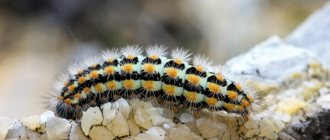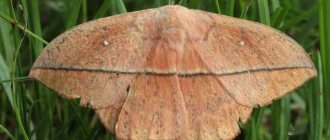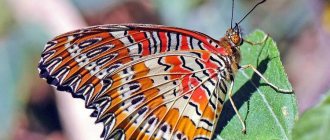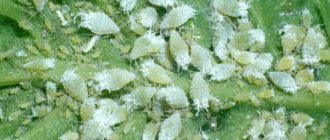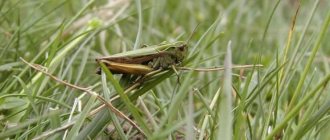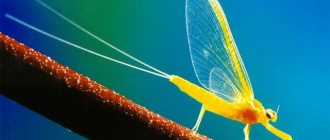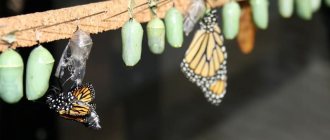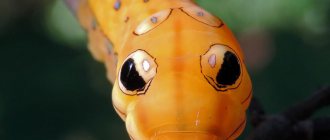Butterfly breeding
The shape and color of the wings are of great importance when breeding butterflies. Some species are sexually dimorphic: males and females differ in appearance, which makes it easier for lepidopterans to find a partner. Other species use pheromones to attract mates. Depending on the species, either males or females can attract a partner in this way. The mating dance is also characteristic of butterflies.
Mating occurs on plant leaves or the ground. It can last from 20 minutes to several hours. By fertilizing a female, the male not only transfers his seed, but also components that are useful during pregnancy. Some species have an interesting feature: after fertilization, a chitinous appendage appears on the female’s abdomen, which eliminates the possibility of repeated mating.
The mating process of the heliconid charitonia is interesting. The female begins to emit pheromones several hours before emerging from the pupa. Males flock to her and begin to fight with each other. The winning male fertilizes the pouch as it emerges from the pupa.
After fertilization, the female lays eggs. This is how butterflies are born. In the tropics, some species can produce up to three generations in one year.
What is metamorphosis and why is it needed?
Metamorphosis, i.e. a life cycle with a series of successive transformations is a very successful acquisition in the struggle for existence. Therefore, it is widespread in nature and is found not only in insects, but also in other living organisms. Metamorphosis allows different stages of the same species to avoid competition among themselves for food and habitat. After all, the larva eats different food and lives in a different place; there is no competition between the larvae and adults. Caterpillars gnaw leaves, adult butterflies calmly feed on flowers - and no one bothers anyone. Through metamorphosis, the same species simultaneously occupies several ecological niches (feeding on both leaves and flowers in the case of butterflies), which also increases the species' chances of survival in a constantly changing environment. After the next change, at least one of the stages will survive, which means the entire species will survive and continue to exist.
Caterpillar
In most cases, butterflies lay eggs on specially selected plants. The small caterpillar hatches from the egg and first eats its shell. Afterwards, it begins to feed on the plant on which it is located. If a butterfly lays eggs on the wrong plant, the caterpillar may refuse to eat and look for more suitable food. At this stage of development, the caterpillar stores nutrients that will serve it for the rest of its life.
The caterpillar eats a lot and grows greatly in size in a short time. The skin of a caterpillar is not elastic, so in order to grow, it molts: it sheds its old skin, which has become narrow. To do this, the caterpillar is attached to the plant with a silk thread. The old skin bursts and the larva crawls out. It takes a little time for the new leather to become strong enough. Afterwards the caterpillar begins to eat again.
On average, a caterpillar molts five times before pupating. Before a butterfly emerges from a caterpillar, its body must undergo an astonishing metamorphosis. When the time comes, the insect is attached to a branch or leaf of a plant with a silk thread. She can hold onto the thread with her hind paws or wrap herself around it crosswise.
Project “How butterflies appear”
Zabotlina Natalya
Project “How butterflies appear”
Project
"How do butterflies appear ?"
Zabotlina N. A.
June 2022
Project “How do butterflies appear ?”
Municipal budgetary preschool educational institution "Kindergarten No. 62"
Educational and research project
"Where do butterflies "
Introduction
Butterflies are beautiful creatures that look like fairy-tale elves or fluttering flowers. Most butterflies are beneficial . They are plant pollinators, serve as food for various animals, bring joy to humans and decorate our planet.
During their short life, these amazing creatures undergo a number of transformations before becoming beauties.
Goal: generalization of children's ideas about butterflies , their structure, adaptability to the environment, lifestyle
Tasks:
Educational:
teach children to observe a living object - a butterfly , analyze, draw conclusions,
project implementation activities .
Educational:
develop observation skills and the ability to establish relationships using the example of the butterfly .
Educational:
cultivate curiosity, the desire to admire the beauty of butterflies , the ability to express this desire in art and speech creativity
Targets:
children have an idea about the development cycle of a butterfly , its way of life, the diversity of the world of butterflies
Project direction : educational - research, creative.
Type of project : Thematic, group, short-term.
Dates: June 2022
Educational field. Cognitive development
Contents of educational activities in various educational areas: “Speech development”
,
“Social and communicative development”
,
“Artistic and aesthetic development”
,
“Physical development”
Activities:
gaming, motor, cognitive-research, communicative, reading, visual, labor.
Relevance.
Expanding knowledge about butterflies
Project participants : teacher, students.
Developmental environment.
Living objects: caterpillar, pupa, butterfly . Books, literary
Doll
To find out how butterflies are born, it is worth considering the processes that occur inside the pupa. The pupa is motionless and cannot escape from a predator, therefore this is the most defenseless stage in the life of a butterfly. That is why the dolls have such a variety of shapes and colors. They camouflage themselves with foliage and greenery. Some butterflies (such as silkworms) spin protective cocoons that provide additional protection.
With the help of the juice with which the caterpillar digests food, it liquefies its own body. The cells that are formed as a result of this process are called imaginal. They are able to change properties depending on the organ they are to become.
In most cases, the complete transformation from caterpillar to butterfly takes approximately two weeks. There are species in which this process can last for several years. The rate of development of the butterfly in the pupa depends on the external temperature and humidity. Some butterflies pupate before winter to survive the cold.
Stages of butterfly development
Butterflies are insects with a full cycle of transformation, that is, they go through all stages of development:
- egg;
- larva (caterpillar);
- chrysalis;
- imago (adult).
Each stage of the transformation of a caterpillar into a butterfly takes time and has its own characteristics.
Where do caterpillars come from and how do they grow?
After mating, the butterfly lays eggs. The number of eggs in a brood depends on the species to which the insect belongs. Some butterflies lay up to 1000 eggs.
But this does not mean that after a while 1000 larvae will be born. Butterfly eggs have many enemies among insects, and their development is greatly influenced by humidity and air temperature.
The eggs have a completely different shape. They can be oval, round, pear-shaped, flattened, cylindrical, cone-shaped.
The main color is light green, but there are also white, cream, blue, brown, red, yellow and other shades. Butterflies lay eggs singly or in groups.
The attitude towards future offspring varies greatly among different species of insects.
Some females scatter eggs everywhere, others attach them with a sticky secretion to a food plant so that the emerging larvae do not have to look for food, and still others lay them in a secluded place, covering them with their own hair.
The dense shell of the egg (chorion) protects the developing larva from mechanical stress and drying out. Inside the egg, in addition to the embryo, there is a supply of nutrients that ensure the growth and development of the future caterpillar.
The egg stage in most butterflies lasts from 1 to 3 weeks, but in some species it can last for months. The larva emerging from the egg looks like a tiny worm.
Its size, depending on the type, can vary from 1 to 5 mm. After the caterpillar hatches from the egg, it goes in search of food.
What a caterpillar eats is also determined by its species. This is mainly plant food: flowers, leaves, berries and fruits. Some people eat moss, mushrooms, horny substances, wax, and plant bark.
But there are also predators that eat aphids, worms and other caterpillars. Good nutrition is very important for the caterpillar, as it allows you to quickly gain weight and obtain enough material to form the cocoon of the future butterfly.
From caterpillar to chrysalis
As the caterpillar grows, it is released repeatedly. The average number of moults ranges from 4 to 7, but some species can mutate up to 40 times.
After each moult, the larva changes, and the changes affect not only the size, but also the color and even the structure of the body. In some types of transformations they are almost invisible, in others they are quite clearly manifested.
After the last moult, the caterpillar turns into a pupa. Shortly before the pupa, the larvae stop eating. Many begin to behave restlessly, constantly moving in search of the most suitable place.
Some species of caterpillars look for a secluded place to pupate, while others pupate openly. The process can occur on the ground, underground, on a leaf or on the stem of a plant.
The caterpillar larva forms a cocoon by releasing silk threads. The entire time the cocoon is being formed, the larva remains in one place, held firmly by its paws.
It is in the cocoon that the transformation of a caterpillar into a butterfly occurs.
From chrysalis to butterfly
While in chrysalis form, caterpillars are most vulnerable. They are motionless and cannot protect themselves from predators - birds and insects. The only thing that saves them is that the cocoon usually looks unpretentious and does not stand out much from the background of the environment.
Despite the fact that no movement is noticeable from the outside, many complex processes are taking place inside the cocoon at this time. The transformation of a larva into an adult (imago) in butterflies is called metamorphosis.
The final form of the insect is almost completely different from the intermediate form, that is, the larva. You can recognize the former caterpillar only by its paws.
In the case of butterflies, the caterpillar, once in the cocoon, secretes special substances, under the influence of which its body becomes liquid.
In this mass, imaginary discs are preserved, that is, groups of cells responsible for the formation of new tissues and organs of the future butterfly.
When the metamorphosis is completely completed, the insect secretes enzymes that devour the shell, after which the butterfly can emerge from the cocoon. First the head appears, then the torso and legs are compressed.
Immediately after the butterfly appears, it still cannot fly. His wings are wet and curled. The insect crawls higher and remains motionless until the wings expand, dry out and become strong.
Subsequently, the butterfly may make its first flight to find a mate for mating, then lay eggs and continue the butterfly lineage.
How long does the transformation take?
The time that passes from the moment the pupa is formed until the butterfly emerges varies greatly depending on the type of insect, climate zone and environmental conditions. In most cases, the revival process takes 2-3 weeks.
But in some species, the pupa takes much longer to transform into a butterfly. Some species overwinter as a pupa, while others spend several years in this state.
For example, in the fuzzy cocoon moth, the pupal stage can last up to 8 years. If external conditions are unfavorable, the butterfly is in no hurry to appear and waits.
It is difficult to predict what a butterfly will look like based on the appearance of a caterpillar. Sometimes the larva and adult insect are completely different, and in some cases the similarities are visible to the naked eye.
Butterfly
How are butterflies born? Cocoon-weaving butterflies can make their way out of the threads to get out. Sometimes they secrete a special liquid that liquefies the silk threads. An ordinary pupa simply cracks and a butterfly emerges from it. Immediately after emerging, the insect's wings are wrinkled and tender. To straighten them, the butterfly looks for a special place. It hangs on a leaf or branch and hangs its wings. Afterwards, the butterfly begins to fill them with lymph, due to which they straighten out. If the butterfly does not have time to quickly get out of the cocoon, or it has nowhere to spread its wings, they will soon dry out, and such an insect will no longer be able to fly.
Usually butterflies emerge from their chrysalis in the early morning when the humidity is high. It may take several hours for the wings to become stronger. Afterwards she is already able to fly. The butterfly takes off and begins searching for a partner to mate with.
Thus, we looked at how butterflies are born. Their life cycle amazes the minds with its complexity and unusualness. After emerging from their pupae, butterflies do not live long. They delight the human eye with their beauty for only a few days, and then they die.
Butterfly structure
The butterfly's body consists of three sections - the head, thorax and abdomen, which contains internal organs.
The head bears antennae, palps, complex compound eyes and mouthparts. The vast majority of butterflies have mouthparts of the sucking type and are a thin long tube-proboscis, which is curled into a spiral when at rest. Many butterflies have underdeveloped mouthparts and are thus unable to feed, subsisting on energy reserves accumulated during the caterpillar stage.
The antennae of butterflies are an organ of smell and come in various shapes - filamentous, club-shaped, feathery, comb-shaped and others. The sense of smell of some butterflies is very developed; males of such species are able to detect the scent of a female at a considerable distance.
The chest of butterflies bears three pairs of jointed legs and two pairs of wings, while the females of some species have underdeveloped wings or are completely wingless, and in some species they are also legless. The pattern on the wings of butterflies is formed by the scales covering them, hence the scientific name of the order - Lepidoptera.
Progress of the lesson:
Today we will continue to get acquainted with the wonderful world of insects. Guess the riddle and find out who exactly.
Butterfly riddle
The flower was sleeping and suddenly woke up - He didn’t want to sleep anymore. He moved, perked up, soared up and flew away.
There are many butterflies in our country. Both night and day. Try to figure out for yourself which butterflies are called day and which are nocturnal. (Children's answers). Diurnal butterflies are active during the day and have brighter colors to be invisible on flowers. Moths rest during the day and fly at night. They do not need such bright colors on their wings as daytime butterflies.
The wings of butterflies are covered with small scales, which are covered with dyes. This is what gives butterflies their wonderful wing colors. But these colored scales are very, very fragile. Therefore, if you pick up a butterfly, you can damage these scales and then the butterfly will die. Do not pick up butterflies and do not allow others to do so. Save the beauty.
The butterfly's mouth is a long, thin proboscis. Usually it is curled into a tight spring, but as soon as a butterfly sits on a flower, the proboscis unfolds and descends to the very bottom of the flower to collect nectar. Insects use their antennae to sniff. Antennae sense odors from afar.
Let's remember how the childhood of insects goes through the example of butterflies.
— First, the butterfly lays eggs. — The eggs hatch into caterpillar larvae. They eat plant foliage in large quantities. Some larvae are so voracious that they can eat all the foliage on some plants. — Having eaten, the caterpillar grows and begins to secrete a thin thread from a hole in its abdomen. She wraps herself with this thread, turning into a cocoon or pupa. The pupa attaches itself to the bark of a tree, hides under the leaves and freezes.
“Although the pupa seems completely motionless, an insect is growing inside it.
— Finally, the butterfly hatches from the pupa.
It's time to play a little.
Interesting Facts
- The breathing process of caterpillars involves spiracles (stigmas), openings in the lateral parts of the abdomen and chest.
- The total number of muscles present in the body of caterpillars is 4000. The head segment alone contains 248 muscles.
- Caterpillars have poor eyesight. The stalks, which are six tiny eyes present on both sides of the head, help in capturing images.
- Some species of caterpillars are poisonous in nature; they can shoot poisonous acids to protect themselves.
- The smallest caterpillar is a member of the moth family. Some of them are no more than one millimeter in size.
- The largest caterpillar is considered to be the Atlas peacock eye caterpillar (Attacus atlas). Its body length can reach 12 centimeters in length.
- The most beautiful caterpillar is the black swallowtail butterfly with white, orange and black stripes.
- During the process of growth, some species change color, pattern, number of hairs on the body and even shape.
- The only period when most of them stop feeding is the time before pupation, when their bodies have already begun metamorphosis - the transformation from caterpillar to butterfly. However, some species may not feed for several months during the winter.
Where do caterpillars come from: the life cycle of butterflies
The female lays eggs after fertilization. Under favorable conditions, a larva develops inside. The process takes from 2 to 14 days. Upon completion, they gnaw through the rim of the eggs and crawl out. This is how the caterpillar appears.
The size of the first stage larvae is about 1 mm. They are born with a huge appetite, eat a lot, and grow quickly. As they grow older, they undergo an average of 4 molts, but there are species that are reborn up to 16 times. The duration of this cycle depends on the type of insect and habitat. In our area, females manage to give birth to two generations; the larva develops in about 6 weeks.
Caterpillars live under the bark of trees, in cereals, grains, and under the leaves of various plants. They feed on juices and gain strength. At the imago stage, the moth lives from several days to 20 days. During this time, it either does not eat anything or feeds on plant nectar, juices of berries, and fruits.
In northern latitudes, the larva does not have time to go through the full development cycle in one summer; it remains to winter in this form and continues to develop with the onset of warmer weather. Northern species are able to withstand frosts below -70 degrees Celsius. In Greenland and Canada, the transformation of a caterpillar into a butterfly lasts 7-14 years.
How long does the egg stage of a butterfly last?
The egg stage in different species can last from several days in the warm season to many months if the eggs overwinter. As the egg develops, a caterpillar forms inside it, which then gnaws through the shell and comes out. In some species, the formed caterpillar overwinters inside the egg and emerges only in the spring. Caterpillars of many species eat the shell of their eggs immediately after emerging.
The body of caterpillars consists of thirteen segments, of which three are thoracic and ten are abdominal. The thoracic segments bear a pair of jointed legs; the abdominal segments usually have five pairs of false legs; some types of abdominal legs have two or three pairs, or they are underdeveloped. The appearance of caterpillars is very diverse and often differs even among closely related species.
Many are brightly and variegatedly colored, some have outgrowths in the form of horns, spikes, and bumps. The surface of the body is smooth with sparse scales or covered with dense hairs, warts, and spines. Body proportions also vary: some caterpillars are short and thick, others are thin and long.
Butterfly survival
There are a huge variety of butterfly species in the world; they are found in almost every corner of the Earth. Some of them travel long distances to other countries. When autumn comes to southeastern Canada, the harbinger of a long, cold winter, the Danaid butterflies, obeying instinct, begin to fly to warm countries. They gather in huge flocks and fly to California and even southern Mexico. The journey takes them about three months. During this time they cover distances of approximately 4 thousand kilometers. Having arrived at the place, they begin to mate and soon die. With the onset of spring, their offspring, obeying the same instinct, returns to Canada.
However, some butterflies are found only in certain regions of the world. Often, conservation organizations report that their numbers have dropped sharply. For example, the rarest (and largest) butterfly on Earth is believed to be the Queen Alexandra's birdwing. It is found only in one part of Papua New Guinea and has now become extremely rare due to forests being cleared for cropland. The wingspan of this butterfly is 30 cm. It is now listed as an endangered species and is protected by international law on the protection of nature. It’s a pity, but some other species of butterflies are also under threat of complete extinction. Several species have already disappeared irrevocably. Among them is the Great Blueberry, which once lived in Great Britain, but has now almost disappeared from the face of the Earth.
Queen Alexandra's Birdwing
This happened because blueberry caterpillars feed on the larvae and eggs of red ants, which built their homes in short, sparse grass. They cannot live on mowing or sown lands. But oddly enough, as a result of coexistence with certain plants, new species of butterflies may appear. For example, heliconid butterflies laid their eggs on the poisonous passionflower plant. The caterpillars fed on the plant, absorbing the poison and becoming inedible to the birds. Subsequently, in order to scare away butterflies, new varieties of passionflower were bred, releasing a different type of poison.
As a result of this, new subspecies of heliconids arose that were capable of absorbing this poison. Some butterfly collectors pay big money for rare specimens. One butterfly, an endangered species, was bought for £1,785. We must do everything possible to preserve the world's current butterfly species in their natural habitat in all their diversity.
To date, about 170 thousand species of Lepidoptera have been discovered. About 90% of them are moths. Butterflies are very beautiful representatives of insects. They are varied in size and color. Here are some of them.
Breeding tropical butterflies from cocoons at home.
In order for the butterflies to emerge from the cocoon at home, I needed: a plastic container, gauze, cocoons of Morpho and Caligo butterflies (purchased at the “butterfly” museum). The gauze must be moistened generously with water to create a moist environment and placed on the bottom of the container. The cocoons must be hung. To do this, you can stretch gauze over the top of the container and tie them to it. I tied the cocoons to the lid, since there were holes in it and it did not prevent air from entering the container. The next day, butterflies appeared from the cocoons.
When a butterfly emerges from a cocoon, it needs to hang on it for several hours, holding on to its legs, so that its wings become stronger. After 2 hours, the appearance of the butterflies changed.
After some time, the butterflies detached themselves from the cocoon and I released them to freedom.
Order of butterflies, or Lepidoptera
Lepidoptera are the largest group of insects from the phylum arthropods. A characteristic feature of all representatives of the order of butterflies is the scaly multi-colored cover of the body and wings. These scales are nothing more than modified hairs. They have different colors and can create complex and bizarre patterns.
We invite you to familiarize yourself with Stride Plus for dogs: composition, side effects, instructions for use, analogues
Another identifying feature of the order of butterflies is the sucking mouthparts in the form of a long tubular proboscis. To eat, the butterfly extends its long proboscis, plunges it deep into the flower and sucks up the nectar.
The main source of food for the order of butterflies is the nectar of flowers, so they are considered the main pollinators of flowering plants. There is an opinion that with the advent of flowers on Earth, butterflies appeared.
Today there are about 150,000 species of squamates that live on all continents except Antarctica. Tropical areas are especially rich in brightly colored butterflies. In addition to butterflies, there are several other similar orders of insects: Homoptera, Diptera, fleas. We invite you to get acquainted with the main representatives of each squad:
- Homoptera. There are more than 30,000 species. These include cicadas, whiteflies, psyllids, scale insects, aphids, gall midges, and scale insects. All of them belong to sucking insects that feed on plant sap. They have a piercing-sucking mouth like a proboscis. Why are they called Homoptera? Nature has endowed them with two pairs of transparent wings - front and rear.
- Diptera. This order includes a million species. They arose more than 100 million years ago. Everyone is familiar with mosquito bites and annoying flies. They have a front pair of wings. Their hind wings can be called small appendages - halteres, which maintain balance during flight.
- Fleas. There are more than 1000 species. These are small insects without wings and with flattened sides. The size of fleas is from 1 to 5 mm. They have a large abdomen and legs, but a small chest and head. They have a slippery and smooth body dotted with bristles and hairs. All this is to make it easier to move through the fur of animals where fleas live. An adult flea is a bloodsucker that parasitizes birds and mammals.
Tropical butterflies.
After visiting the museum before starting my work, I decided to conduct a survey among my classmates “What do I know about butterflies?” You can see the results of the survey on the slide. They didn’t make me very happy, and after this research I decided that I would definitely share my knowledge and discoveries with the guys. Having studied additional literature and information from the Internet, I learned a lot of interesting things.
About 200 thousand species of butterflies live on the planet, of which about 150 thousand species are in the tropics. It is there that the most beautiful representatives of the flora on the planet are located. Temperatures in the tropics never drop below zero and the breeding process of butterflies is almost continuous throughout the year. But, despite this, many species of tropical butterflies are listed in the Red Book.
Does the butterfly remember what the caterpillar learned?
Scientists have long paid little attention to the intelligence of insects due to their tiny brains with up to 1 million neurons. However, a number of studies have confirmed that they have some abilities on par with many vertebrates.
To understand whether the butterfly remembers what the caterpillar learned, scientists from Georgetown University conducted several experiments with hawk moths. The essence of the experiment was to first teach the caterpillar to distinguish certain odors, and then check whether this information would be transmitted to the butterfly.
Tobacco hawk moth
During the study, the delivery of certain odors was accompanied by light pulses of electrical current. The larvae were trained and began to avoid these aromas. To confirm or deny the presence of memories, the researchers waited until the caterpillar went through the pupal phase and turned into an adult.
The results were mixed. Only those moths whose learning occurred in the later stages of larval development avoided characteristic odors. Early training did not bear any fruit. Experts suggest that immediately before the caterpillar turns into an adult, key parts of the nervous system are laid down, which allow the memories acquired at this stage to be preserved.
If you find an error, please select a piece of text and press Ctrl+Enter.
Types of caterpillars
In nature, there are many types of caterpillars that differ in size, color and other features. However, only a few of them have become more widely known.
Among them:
- Cabbage caterpillar. The insect's habitat is Eastern Europe, from North Africa to the Japanese islands. Subsequently it came to South America, where it was introduced. This green caterpillar is the larva of the cabbage butterfly. The length of its body is about 3.5 cm. The insect has 8 pairs of limbs. On the surface of the body there are black warts and short hairs of the same color.
- Moth caterpillar. The insect has an elongated body. Its peculiarity is its underdeveloped abdominal limbs, so it moves in a loop-like manner, bending the body in an arc. This makes it possible to move the back of the body forward. The color of the moth larva can be green or brown, depending on the variety.
- Large harpy larva. It lives in Europe, Central Asia, and northern Africa. The length of adult individuals reaches 6 cm. The color of insects is green with a purple diamond on the back, which has a light outline.
- Redtail caterpillar. Distributed in the forest-steppe of Eurasia, as well as Asia. It grows up to 5 cm in length. It can have a pink, brown or gray color. The body of the insect is densely covered with hairs, and at the end of the body there is a tail from which crimson bristles protrude. This species belongs to the category of poisonous. When it comes into contact with human skin, irritation occurs.
- Silkworm larva. The caterpillar is found in East Asia, Russia, and China. The length of the caterpillar reaches 6-7 cm. The body of the larva is warty and shaggy. Initially, the villi are blue and brown, but after the fourth molt they become yellow. The silkworm larva feeds exclusively on mulberry leaves.
- Corrosive woodworm caterpillar. This species is found in almost all European countries. During wintering, the color changes from yellow-pink to orange. There are black glossy warts on the body. The length of the insect reaches 5-6 cm. Its usual habitat is inside branches and tree trunks. The larvae feed on plant sap.
- Swallowtail caterpillar. This species is considered one of the most colorful. Found in Europe, Asia, North America, and Africa. At the initial stage of larval development, the body is black with scarlet warts. As it develops, it turns green and black transverse lines appear, each with 6-8 red-orange spots. In case of danger, the swallowtail caterpillar secretes a liquid with a specific odor. This species feeds on the leaves of carrots, celery, wormwood, parsley, and alder.
Great Harpy Larva
Pupa stage
Butterflies have sedentary pupae. The main type characteristic of Lepidoptera is glued. In some families, such as cocoon moths, the pupa lives inside a cocoon that was woven by a caterpillar. The shape is cylindrical, sometimes round. - from light colors to dark ones with the presence of stripes and inclusions. Usually the pupa is located inside glued leaves on the trunks and flowers of plants with the rudiments of the abdomen, wings, legs and proboscis already clearly visible. At this stage of development there is no nutrition.
What do butterflies eat?
Pollen and nectar from flowering plants are the main diet of butterflies. Some species of butterflies are not averse to feasting on tree sap and rotten fruit. There is also such an interesting butterfly as the death's head hawk moth, it is notable for the fact that it loves to fly into the hive of bees and feast on their honey.
Sometimes among butterflies there are real gourmets, for example, some tropical butterflies drink the tears of turtles and crocodiles.
Interesting fact: among butterflies, there are also those that completely lack mouthparts. How do they eat?! But in no way, the fact is that in order to maintain life, they use up the reserves of nutrients that they accumulated when they were still caterpillars. One such unusual butterfly is the Madagascar comet. Of course, life expectancy with such nutrition (or rather the complete absence of it) is only 2-3 days.
Among the numerous kingdom of butterflies, there is also a real vampire butterfly, which, like mosquitoes, feeds on the blood of other animals.
